+ Open data
Open data
- Basic information
Basic information
| Entry |  | |||||||||
|---|---|---|---|---|---|---|---|---|---|---|
| Title | Dimeric CD163 bound to human haptoglobin-haemoglobin complex | |||||||||
 Map data Map data | Deep EMhancer-sharpened map | |||||||||
 Sample Sample |
| |||||||||
 Keywords Keywords | CD163 / haptoglobin-haemoglobin complex / haemoglobin detoxification / ligand uptake / scavenger receptor / SRCR domain-containing protein / ENDOCYTOSIS | |||||||||
| Function / homology |  Function and homology information Function and homology informationnegative regulation of hydrogen peroxide catabolic process / zymogen activation / CD163 mediating an anti-inflammatory response / scavenger receptor activity / nitric oxide transport / hemoglobin alpha binding / cellular oxidant detoxification / hemoglobin binding / haptoglobin-hemoglobin complex / renal absorption ...negative regulation of hydrogen peroxide catabolic process / zymogen activation / CD163 mediating an anti-inflammatory response / scavenger receptor activity / nitric oxide transport / hemoglobin alpha binding / cellular oxidant detoxification / hemoglobin binding / haptoglobin-hemoglobin complex / renal absorption / antioxidant activity / hemoglobin complex / oxygen transport / immune system process / Scavenging of heme from plasma / endocytic vesicle lumen / blood vessel diameter maintenance / acute-phase response / hydrogen peroxide catabolic process / oxygen carrier activity / carbon dioxide transport / response to hydrogen peroxide / Heme signaling / Erythrocytes take up oxygen and release carbon dioxide / Erythrocytes take up carbon dioxide and release oxygen / Late endosomal microautophagy / defense response / Cytoprotection by HMOX1 / oxygen binding / regulation of blood pressure / platelet aggregation / specific granule lumen / Chaperone Mediated Autophagy / positive regulation of nitric oxide biosynthetic process / endocytic vesicle membrane / tertiary granule lumen / Factors involved in megakaryocyte development and platelet production / scaffold protein binding / blood microparticle / ficolin-1-rich granule lumen / defense response to bacterium / iron ion binding / inflammatory response / external side of plasma membrane / serine-type endopeptidase activity / heme binding / Neutrophil degranulation / extracellular space / extracellular exosome / extracellular region / metal ion binding / membrane / plasma membrane / cytosol Similarity search - Function | |||||||||
| Biological species |  Homo sapiens (human) Homo sapiens (human) | |||||||||
| Method | single particle reconstruction / cryo EM / Resolution: 2.82 Å | |||||||||
 Authors Authors | Zhou RX / Higgins MK | |||||||||
| Funding support |  United Kingdom, 2 items United Kingdom, 2 items
| |||||||||
 Citation Citation |  Journal: Nat Commun / Year: 2025 Journal: Nat Commun / Year: 2025Title: Scavenger receptor CD163 multimerises to allow uptake of diverse ligands. Authors: Richard X Zhou / Matthew K Higgins /  Abstract: CD163 is an archetypal scavenger receptor and mediates detoxification of free haemoglobin. Release of haemoglobin from lysed erythrocytes causes oxidative tissue and organ damage. Detoxification ...CD163 is an archetypal scavenger receptor and mediates detoxification of free haemoglobin. Release of haemoglobin from lysed erythrocytes causes oxidative tissue and organ damage. Detoxification involves haemoglobin binding to the abundant serum protein haptoglobin, followed by CD163-mediated uptake of stoichiometrically diverse haptoglobin-haemoglobin complexes into macrophages for degradation. We show that CD163 adopts dimeric and trimeric assemblies due to calcium-mediated interactions within a membrane-associated base. Arms protrude from this base and create a ligand-binding site. Flexibility within the base, coupled with multiple small ligand-binding surfaces on each arm, allow the receptor to mould around its ligands, resulting in promiscuous uptake of ligands with different structures and stoichiometries. Monomeric CD163 lacks this ability to internalise lower-avidity ligands. Arms from adjacent protomers can also self-associate, blocking ligand-binding surfaces in an autoinhibited state. Therefore, through calcium-dependent multimer formation and flexible ligand binding, CD163 scavenges ligands with different structures and avidities, mediating haemoglobin detoxification. | |||||||||
| History |
|
- Structure visualization
Structure visualization
| Supplemental images |
|---|
- Downloads & links
Downloads & links
-EMDB archive
| Map data |  emd_52078.map.gz emd_52078.map.gz | 452.1 MB |  EMDB map data format EMDB map data format | |
|---|---|---|---|---|
| Header (meta data) |  emd-52078-v30.xml emd-52078-v30.xml emd-52078.xml emd-52078.xml | 25.1 KB 25.1 KB | Display Display |  EMDB header EMDB header |
| FSC (resolution estimation) |  emd_52078_fsc.xml emd_52078_fsc.xml | 16.9 KB | Display |  FSC data file FSC data file |
| Images |  emd_52078.png emd_52078.png | 108 KB | ||
| Filedesc metadata |  emd-52078.cif.gz emd-52078.cif.gz | 7.4 KB | ||
| Others |  emd_52078_additional_1.map.gz emd_52078_additional_1.map.gz emd_52078_half_map_1.map.gz emd_52078_half_map_1.map.gz emd_52078_half_map_2.map.gz emd_52078_half_map_2.map.gz | 255.3 MB 475.5 MB 475.5 MB | ||
| Archive directory |  http://ftp.pdbj.org/pub/emdb/structures/EMD-52078 http://ftp.pdbj.org/pub/emdb/structures/EMD-52078 ftp://ftp.pdbj.org/pub/emdb/structures/EMD-52078 ftp://ftp.pdbj.org/pub/emdb/structures/EMD-52078 | HTTPS FTP |
-Validation report
| Summary document |  emd_52078_validation.pdf.gz emd_52078_validation.pdf.gz | 613 KB | Display |  EMDB validaton report EMDB validaton report |
|---|---|---|---|---|
| Full document |  emd_52078_full_validation.pdf.gz emd_52078_full_validation.pdf.gz | 612.5 KB | Display | |
| Data in XML |  emd_52078_validation.xml.gz emd_52078_validation.xml.gz | 26.2 KB | Display | |
| Data in CIF |  emd_52078_validation.cif.gz emd_52078_validation.cif.gz | 34.7 KB | Display | |
| Arichive directory |  https://ftp.pdbj.org/pub/emdb/validation_reports/EMD-52078 https://ftp.pdbj.org/pub/emdb/validation_reports/EMD-52078 ftp://ftp.pdbj.org/pub/emdb/validation_reports/EMD-52078 ftp://ftp.pdbj.org/pub/emdb/validation_reports/EMD-52078 | HTTPS FTP |
-Related structure data
| Related structure data |  9hejMC  9hekC  9helC M: atomic model generated by this map C: citing same article ( |
|---|---|
| Similar structure data | Similarity search - Function & homology  F&H Search F&H Search |
- Links
Links
| EMDB pages |  EMDB (EBI/PDBe) / EMDB (EBI/PDBe) /  EMDataResource EMDataResource |
|---|---|
| Related items in Molecule of the Month |
- Map
Map
| File |  Download / File: emd_52078.map.gz / Format: CCP4 / Size: 512 MB / Type: IMAGE STORED AS FLOATING POINT NUMBER (4 BYTES) Download / File: emd_52078.map.gz / Format: CCP4 / Size: 512 MB / Type: IMAGE STORED AS FLOATING POINT NUMBER (4 BYTES) | ||||||||||||||||||||||||||||||||||||
|---|---|---|---|---|---|---|---|---|---|---|---|---|---|---|---|---|---|---|---|---|---|---|---|---|---|---|---|---|---|---|---|---|---|---|---|---|---|
| Annotation | Deep EMhancer-sharpened map | ||||||||||||||||||||||||||||||||||||
| Projections & slices | Image control
Images are generated by Spider. | ||||||||||||||||||||||||||||||||||||
| Voxel size | X=Y=Z: 0.832 Å | ||||||||||||||||||||||||||||||||||||
| Density |
| ||||||||||||||||||||||||||||||||||||
| Symmetry | Space group: 1 | ||||||||||||||||||||||||||||||||||||
| Details | EMDB XML:
|
-Supplemental data
-Additional map: unsharpened map
| File | emd_52078_additional_1.map | ||||||||||||
|---|---|---|---|---|---|---|---|---|---|---|---|---|---|
| Annotation | unsharpened map | ||||||||||||
| Projections & Slices |
| ||||||||||||
| Density Histograms |
-Half map: half map B
| File | emd_52078_half_map_1.map | ||||||||||||
|---|---|---|---|---|---|---|---|---|---|---|---|---|---|
| Annotation | half map B | ||||||||||||
| Projections & Slices |
| ||||||||||||
| Density Histograms |
-Half map: half map A
| File | emd_52078_half_map_2.map | ||||||||||||
|---|---|---|---|---|---|---|---|---|---|---|---|---|---|
| Annotation | half map A | ||||||||||||
| Projections & Slices |
| ||||||||||||
| Density Histograms |
- Sample components
Sample components
-Entire : CD163:HpHb complex
| Entire | Name: CD163:HpHb complex |
|---|---|
| Components |
|
-Supramolecule #1: CD163:HpHb complex
| Supramolecule | Name: CD163:HpHb complex / type: complex / ID: 1 / Parent: 0 / Macromolecule list: #1-#4 |
|---|---|
| Source (natural) | Organism:  Homo sapiens (human) Homo sapiens (human) |
-Macromolecule #1: Scavenger receptor cysteine-rich type 1 protein M130
| Macromolecule | Name: Scavenger receptor cysteine-rich type 1 protein M130 / type: protein_or_peptide / ID: 1 / Number of copies: 2 / Enantiomer: LEVO |
|---|---|
| Source (natural) | Organism:  Homo sapiens (human) Homo sapiens (human) |
| Molecular weight | Theoretical: 125.594805 KDa |
| Recombinant expression | Organism:  Homo sapiens (human) Homo sapiens (human) |
| Sequence | String: MSKLRMVLLE DSGSADFRRH FVNLSPFTIT VVLLLSACFV TSSLGGTDKE LRLVDGENKC SGRVEVKVQE EWGTVCNNGW SMEAVSVIC NQLGCPTAIK APGWANSSAG SGRIWMDHVS CRGNESALWD CKHDGWGKHS NCTHQQDAGV TCSDGSNLEM R LTRGGNMC ...String: MSKLRMVLLE DSGSADFRRH FVNLSPFTIT VVLLLSACFV TSSLGGTDKE LRLVDGENKC SGRVEVKVQE EWGTVCNNGW SMEAVSVIC NQLGCPTAIK APGWANSSAG SGRIWMDHVS CRGNESALWD CKHDGWGKHS NCTHQQDAGV TCSDGSNLEM R LTRGGNMC SGRIEIKFQG RWGTVCDDNF NIDHASVICR QLECGSAVSF SGSSNFGEGS GPIWFDDLIC NGNESALWNC KH QGWGKHN CDHAEDAGVI CSKGADLSLR LVDGVTECSG RLEVRFQGEW GTICDDGWDS YDAAVACKQL GCPTAVTAIG RVN ASKGFG HIWLDSVSCQ GHEPAIWQCK HHEWGKHYCN HNEDAGVTCS DGSDLELRLR GGGSRCAGTV EVEIQRLLGK VCDR GWGLK EADVVCRQLG CGSALKTSYQ VYSKIQATNT WLFLSSCNGN ETSLWDCKNW QWGGLTCDHY EEAKITCSAH REPRL VGGD IPCSGRVEVK HGDTWGSICD SDFSLEAASV LCRELQCGTV VSILGGAHFG EGNGQIWAEE FQCEGHESHL SLCPVA PRP EGTCSHSRDV GVVCSRYTEI RLVNGKTPCE GRVELKTLGA WGSLCNSHWD IEDAHVLCQQ LKCGVALSTP GGARFGK GN GQIWRHMFHC TGTEQHMGDC PVTALGASLC PSEQVASVIC SGNQSQTLSS CNSSSLGPTR PTIPEESAVA CIESGQLR L VNGGGRCAGR VEIYHEGSWG TICDDSWDLS DAHVVCRQLG CGEAINATGS AHFGEGTGPI WLDEMKCNGK ESRIWQCHS HGWGQQNCRH KEDAGVICSE FMSLRLTSEA SREACAGRLE VFYNGAWGTV GKSSMSETTV GVVCRQLGCA DKGKINPASL DKAMSIPMW VDNVQCPKGP DTLWQCPSSP WEKRLASPSE ETWITCDNKI RLQEGPTSCS GRVEIWHGGS WGTVCDDSWD L DDAQVVCQ QLGCGPALKA FKEAEFGQGT GPIWLNEVKC KGNESSLWDC PARRWGHSEC GHKEDAAVNC TDISVQKTPQ KA TTGRSSR QSSFIAVGIL GVVLLAIFVA LFFLTKKRRQ RQRLAVSSRG ENLVHQIQYR EMNSCLNADD LDLMNSSENS HES ADFSAA ELISVSKFLP ISGMEKEAIL SHTEKENGNL UniProtKB: Scavenger receptor cysteine-rich type 1 protein M130 |
-Macromolecule #2: Hemoglobin subunit alpha
| Macromolecule | Name: Hemoglobin subunit alpha / type: protein_or_peptide / ID: 2 / Number of copies: 1 / Enantiomer: LEVO |
|---|---|
| Source (natural) | Organism:  Homo sapiens (human) Homo sapiens (human) |
| Molecular weight | Theoretical: 15.28155 KDa |
| Sequence | String: MVLSPADKTN VKAAWGKVGA HAGEYGAEAL ERMFLSFPTT KTYFPHFDLS HGSAQVKGHG KKVADALTNA VAHVDDMPNA LSALSDLHA HKLRVDPVNF KLLSHCLLVT LAAHLPAEFT PAVHASLDKF LASVSTVLTS KYR UniProtKB: Hemoglobin subunit alpha |
-Macromolecule #3: Hemoglobin subunit beta
| Macromolecule | Name: Hemoglobin subunit beta / type: protein_or_peptide / ID: 3 / Number of copies: 1 / Enantiomer: LEVO |
|---|---|
| Source (natural) | Organism:  Homo sapiens (human) Homo sapiens (human) |
| Molecular weight | Theoretical: 16.021396 KDa |
| Sequence | String: MVHLTPEEKS AVTALWGKVN VDEVGGEALG RLLVVYPWTQ RFFESFGDLS TPDAVMGNPK VKAHGKKVLG AFSDGLAHLD NLKGTFATL SELHCDKLHV DPENFRLLGN VLVCVLAHHF GKEFTPPVQA AYQKVVAGVA NALAHKYH UniProtKB: Hemoglobin subunit beta |
-Macromolecule #4: Isoform 2 of Haptoglobin
| Macromolecule | Name: Isoform 2 of Haptoglobin / type: protein_or_peptide / ID: 4 / Number of copies: 2 / Enantiomer: LEVO |
|---|---|
| Source (natural) | Organism:  Homo sapiens (human) Homo sapiens (human) |
| Molecular weight | Theoretical: 38.497652 KDa |
| Sequence | String: MSALGAVIAL LLWGQLFAVD SGNDVTDIAD DGCPKPPEIA HGYVEHSVRY QCKNYYKLRT EGDGVYTLNN EKQWINKAVG DKLPECEAV CGKPKNPANP VQRILGGHLD AKGSFPWQAK MVSHHNLTTG ATLINEQWLL TTAKNLFLNH SENATAKDIA P TLTLYVGK ...String: MSALGAVIAL LLWGQLFAVD SGNDVTDIAD DGCPKPPEIA HGYVEHSVRY QCKNYYKLRT EGDGVYTLNN EKQWINKAVG DKLPECEAV CGKPKNPANP VQRILGGHLD AKGSFPWQAK MVSHHNLTTG ATLINEQWLL TTAKNLFLNH SENATAKDIA P TLTLYVGK KQLVEIEKVV LHPNYSQVDI GLIKLKQKVS VNERVMPICL PSKDYAEVGR VGYVSGWGRN ANFKFTDHLK YV MLPVADQ DQCIRHYEGS TVPEKKTPKS PVGVQPILNE HTFCAGMSKY QEDTCYGDAG SAFAVHDLEE DTWYATGILS FDK SCAVAE YGVYVKVTSI QDWVQKTIAE N UniProtKB: Haptoglobin |
-Macromolecule #6: 2-acetamido-2-deoxy-beta-D-glucopyranose
| Macromolecule | Name: 2-acetamido-2-deoxy-beta-D-glucopyranose / type: ligand / ID: 6 / Number of copies: 4 / Formula: NAG |
|---|---|
| Molecular weight | Theoretical: 221.208 Da |
| Chemical component information | 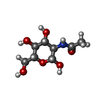 ChemComp-NAG: |
-Macromolecule #7: CALCIUM ION
| Macromolecule | Name: CALCIUM ION / type: ligand / ID: 7 / Number of copies: 9 / Formula: CA |
|---|---|
| Molecular weight | Theoretical: 40.078 Da |
-Macromolecule #8: PROTOPORPHYRIN IX CONTAINING FE
| Macromolecule | Name: PROTOPORPHYRIN IX CONTAINING FE / type: ligand / ID: 8 / Number of copies: 2 / Formula: HEM |
|---|---|
| Molecular weight | Theoretical: 616.487 Da |
| Chemical component information |  ChemComp-HEM: |
-Macromolecule #9: OXYGEN MOLECULE
| Macromolecule | Name: OXYGEN MOLECULE / type: ligand / ID: 9 / Number of copies: 2 / Formula: OXY |
|---|---|
| Molecular weight | Theoretical: 31.999 Da |
| Chemical component information |  ChemComp-O2: |
-Experimental details
-Structure determination
| Method | cryo EM |
|---|---|
 Processing Processing | single particle reconstruction |
| Aggregation state | particle |
- Sample preparation
Sample preparation
| Buffer | pH: 7.5 |
|---|---|
| Vitrification | Cryogen name: ETHANE |
- Electron microscopy
Electron microscopy
| Microscope | TFS KRIOS |
|---|---|
| Image recording | Film or detector model: GATAN K3 BIOQUANTUM (6k x 4k) / Average electron dose: 41.68 e/Å2 |
| Electron beam | Acceleration voltage: 300 kV / Electron source:  FIELD EMISSION GUN FIELD EMISSION GUN |
| Electron optics | Illumination mode: FLOOD BEAM / Imaging mode: BRIGHT FIELD / Nominal defocus max: 2.0 µm / Nominal defocus min: 0.4 µm |
| Experimental equipment |  Model: Titan Krios / Image courtesy: FEI Company |
 Movie
Movie Controller
Controller








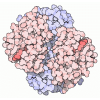
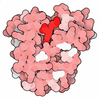
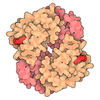
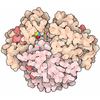
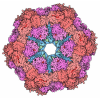


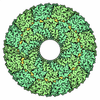

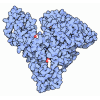


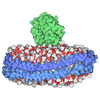


 Z (Sec.)
Z (Sec.) Y (Row.)
Y (Row.) X (Col.)
X (Col.)













































